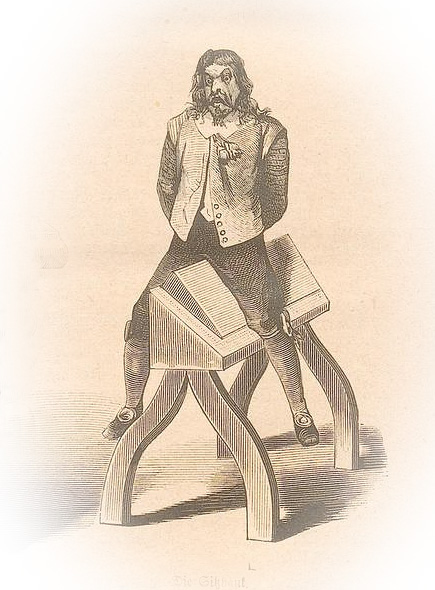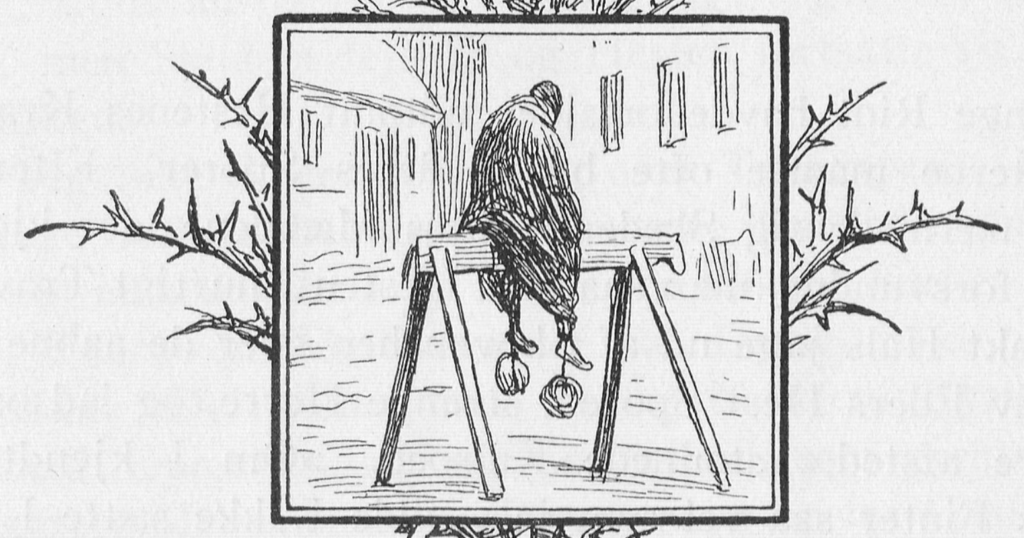At first glance, the so-called Spanish Donkey may not seem menacing. But take a closer look.
It was shaped like a pommel horse in gymnastics, but with a pointed triangular edge facing upwards. This device’s shape ensured that its victims received a gruesomely agonizing experience.
Used first in Medieval Europe, particularly during the Spanish Inquisition, the Spanish Donkey eventually migrated to North America. There, it was used in Canada and the United States. It was even employed by George Washington himself.
It’s time to take a look at one of the most feared punishments ever to exist, the people who used it, and how they could have justified such a horrible method of inflicting pain.

What was the Spanish Donkey?
Quite simply, the Spanish Donkey was the most painful method of execution ever devised.
It was originally designed with women in mind. The offender would be stripped of all of their clothes and then made to straddle what was essentially a triangular piece of metal with a board placed over it to form a sawhorse-type shape.
Often, the victim would then have restraints or weights tied to their ankles in order to make the experience even more painful. Depending on how long a victim was made to sit on the Spanish Donkey, they could experience anything from intense discomfort to agonizing pain to disfigurement and death.
Given enough time, a victim could theoretically be cleaved completely in half, as the weight of their body would cause the metal edge of the device to slice into their lower half and cut them straight down the middle.
Sometimes, the torturers would even tickle or hold a flame up to the bottom of the victim’s feet. This forced them to wriggle about while atop the device, causing even more pain and suffering.
The Spanish Donkey in the Colonial Period
We often associate brutal methods of torture and punishment with the Medieval period. But as horrific as this torture method sounds, it was also used centuries later.
One of the founding fathers, George Washington himself, used the Spanish Donkey as a method for instilling discipline in the unruly colonial army. When George Washington took over command of the Continental Army, it was a rag-tag group of men who had little combat experience and who struggled to adapt to the rigors of army life.
To limit insubordination, drunkenness, and desertion, George Washington employed a number of deterrents that today may seem surprisingly cruel.
For the most severe cases – such as desertion or treason – a soldier could be hung or put before the firing squad. For minor offenses, lashing was probably the most widely administered punishment.

Theft, drunkenness, or tardiness were all sufficient offenses to warrant lashes. Although, the number and method of administering them was up to the officer in charge.
But the Spanish Donkey, also known as the “Wooden Horse” or “The Mule” was also used for minor offenses. For example, on July 10, 1775, George Washington’s orders for the day were as follows:
“The General Court Martial of which Colonel William Prescott was president having tried William Pattin of Colonel Gridley’s regiment, and found him guilty of ‘threatening and abusing a number of persons, when prisoner in the Quarter Guard.’ The Court sentence the prisoner to ride the wooden horse, fifteen minutes. The General [Washington] approves the sentence and orders it to be put in execution at the head of the regiment.”
Order of the General Court Martial, 1775
Of course, a 15-minute ride on the “Wooden Horse” is a far different experience than being forced to spend hours or days on it. Nevertheless, it couldn’t have been a pleasant experience for the unfortunate soldier. It would have no doubt made him think twice before stepping out of line again.
In other areas of colonial North America, however, the “Spanish Donkey” was indeed applied to its fullest extent.
For example, when French Jesuits settled in what is now Canada in the 17th century, they recorded instances of using this terrifying chair to cause lasting damage. Such as when one Frenchman mounted the device until “he was ruptured.”
In modern armies, torture is no longer used to instill discipline. However, it is still used in militaries around the world, just not against a nation’s own soldiers.
Instead, it is controversially used as a way to get valuable information from those deemed to be enemies. And although the methods may have changed, this use of torture goes back at least as far as the Middle Ages.
Why Was Torture Used?
Torture has historically (and currently), been used as a tool for extracting information.
During the Inquisitions, despite the wide variety of wickedly inventive ways to inflict pain and suffering on a person, they all had the same purpose. The Spanish Donkey was just one tool among many that a torturer would use in order to break a victim down both physically and psychologically.
But despite the depictions of people being killed in droves on the rack, the pulley, and similarly heinous devices, torture was often meted out in a very planned, even bureaucratic way.
Torturers wanted to get a confession, but they also realized that information gained under torture couldn’t be trusted. So, they would keep a prisoner locked up for months or years, and administer torture periodically.
Over the course of various torture sessions, if the information continued to remain consistent and matched other sources of information that the authorities had gathered, then the information was deemed reliable.
In this way, torture was far from a sadistic way of exacting revenge or punishing someone for being a heretic. It was a cold-blooded method for gathering the best data possible. In their quest to save souls, Inquisitors needed to get a confession from the accused person – and that confession had to be genuine.
Today, torture remains a controversial topic of debate. Some people believe it is a necessary tool that helps ensure national security, and others believe it is inhumane and ineffective.
While the methods used today are very different from the nightmarish-looking devices such as the rack, the Iron Maiden, and the Spanish Donkey, they are still designed to do the same thing – force a person into confessing.
The Spanish Donkey may no longer be ridden, but its long history forms a link in a chain of violence that stretches from the dungeons of Medieval Europe to the secret military bases of today’s modern world.

